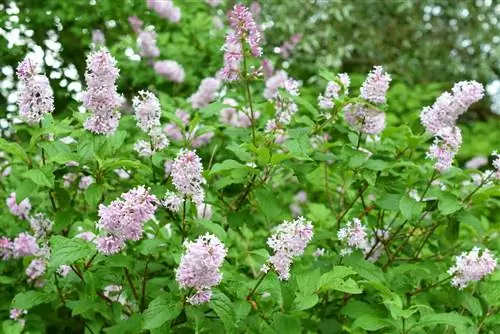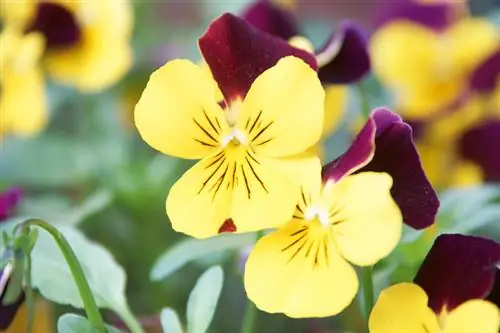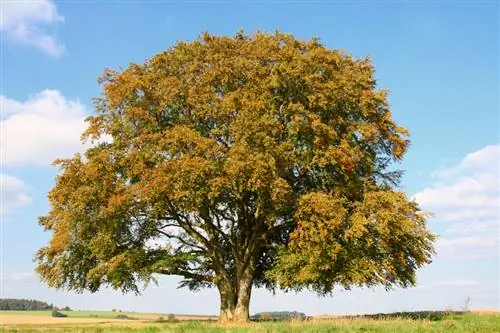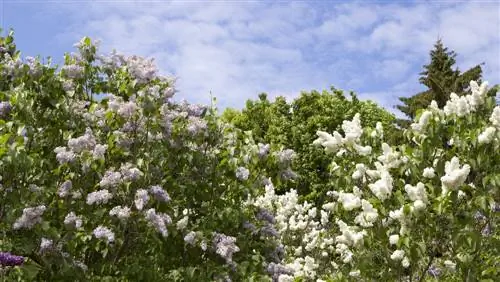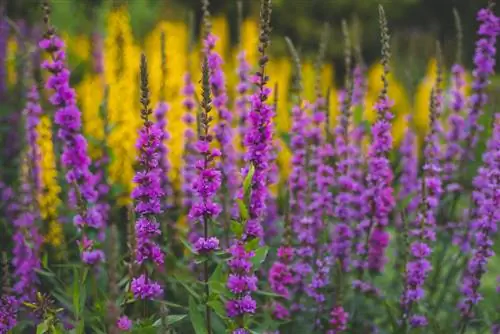- Author admin [email protected].
- Public 2023-12-16 16:46.
- Last modified 2025-01-23 11:21.
The lilac, which originally comes from southeastern Europe, can be found in numerous gardens and is a real feast for the eyes, especially during its flowering period. The shrub or small tree is considered robust and undemanding, and it can also grow very old. The popular tree can also be cultivated in a sufficiently large container, especially if it is a small species such as Syringa meyeri (dwarf lilac) or Syringa microphylla (small-leaved autumn lilac).

What does a lilac profile look like?
Lilac (Syringa) is an ornamental shrub from the olive family and grows as a shrub or small tree. Well-known species are the common lilac (Syringa vulgaris) and the dwarf lilac (Syringa meyeri). The lilac prefers sunny locations, blooms between May and June and produces flower spikes up to 30 cm long in shades of pink, purple and white.
Lilac at a glance
- Botanical name: Syringa
- Genus: Lilac
- Family: Oleaceae
- Species: approx. 30 species, including Syringa vulgaris (Common Lilac), Royal Lilac or Chinese Lilac (Syringa × chinensis), Canadian Lilac or Preston Lilac (Syringa × prestoniae), Dwarf Lilac (Syringa meyeri)
- Origin and distribution: Asia and Europe
- Growth form: shrub-like or tree
- Growth height: depending on the species between 200 and 500 cm
- Location: sunny to light partial shade
- Soil: moderately dry, calcareous, well drained
- Flowers: arranged in flower panicles up to 30 centimeters long
- Flower colors: different shades of pink and purple, white
- Flowering time: usually between May and June, depending on the variety
- Leaves: simple, rarely pinnate
- Use: Ornamental shrub or tree in gardens and parks, as a solitary plant, in groups, as a hedge or (especially small varieties) in a pot
- Toxicity: slightly toxic
- Winter hardiness: yes
- Danger of confusion: Buddleia (Buddleja) because of the similar flowers, black elderberry (Sambucus nigra) because of the name “lilac” (which is also used for elderberry in northern Germany)
Characterization, species and varieties
In gardens and parks you can usually find the common lilac (Syringa vulgaris), which has been cultivated in Central Europe since the 16th century and offers a wide variety of varieties. However, there are a number of other species that bloom just as beautifully - and often also exude the characteristic scent. Lilac is usually grown as a shrub or small tree and, depending on the species and variety, can grow to a height of between 150 and 600 centimeters. Despite the characteristic, sweet scent, the lilac is rarely attacked by insects: It tastes very bitter due to its slightly poisonous ingredients, which especially applies to its flowers and their nectar.
No relation to the buddleia or butterfly lilac
If you want to do something good for butterflies, bumblebees and bees, it would be better to cultivate buddleia or butterfly lilac (Buddleja) instead of the common lilac, which is a popular pasture, especially for butterflies. Despite having the same name and similar flowers, the species are not related to each other.
Tip
On many websites and in some cookbooks you can also find recipes for lilac berries or flowers, for example lilac berry juice or lilac blossom tea, both of which are said to have an antipyretic effect. However, these are not the berries or flowers of the Syringa lilac, but rather those of the black elderberry (Sambucus nigra), which is often referred to as “lilac”, especially in northern Germany - which of course causes confusion.

